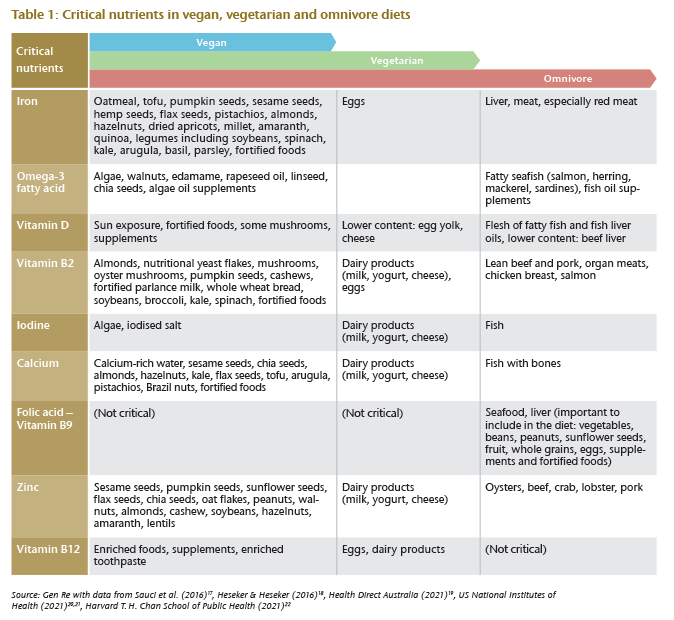-
Property & Casualty
Property & Casualty Overview

Property & Casualty
We offer a full range of reinsurance products and the expertise of our talented reinsurance team.
Expertise
Publication
Recycling of Large Lithium-Ion Batteries From a Property Insurance Perspective
Publication
The Future of Cryptography and the Rise of Quantum Computing
Publication
Personal Injury Compensation in Europe: An Updated Comparison Among Different Systems Within the European Market
Publication
Looks Like Inflation Is Sticking Around. What Do We Do Now? [Part 3 of 3]
Publication
Motor Insurance in the Post-Pandemic Era -
Life & Health
Life & Health Overview

Life & Health
Gen Re’s valuable insights and risk transfer solutions help clients improve their business results. With tailor-made reinsurance programs, clients can achieve their life & health risk management objectives.
UnderwritingTraining & Education
Publication
The Future Impacts on Mortality [Video]
Publication
Thinking Differently About Genetics and Insurance Business School
Business School
Publication
Fraud Survey in the UK & Ireland Sheds Light on Insurer Best Practices
Publication
Fight Against Fraudulent Claims – Highlights From Our South African Survey Moving The Dial On Mental Health
Moving The Dial On Mental Health -
Knowledge Center
Knowledge Center Overview

Knowledge Center
Our global experts share their insights on insurance industry topics.
Trending Topics -
About Us
About Us OverviewCorporate Information

Meet Gen Re
Gen Re delivers reinsurance solutions to the Life & Health and Property & Casualty insurance industries.
- Careers Careers
Food, the Daily Medicine?

February 14, 2022
Dr. Katharina Dorn
,
Dr. Simon Stirnat
English
Français
Many people feel they know what a healthy diet should look like, but it seems to be more difficult to put the knowledge into practice. As Hippocrates advised 3,000 years ago, “Let food be your medicine and medicine be your food”. But to what extent is this true? We will discuss what constitutes a healthy diet, what can be critical or beneficial about restrictive diets that exclude some or all animal products, and why it might be difficult to stay away from predominantly unhealthy fast food. We want to explore how diets can affect health over time, especially for people with known pre-existing conditions, and to what extent diet might be considered during underwriting.
What is a healthy diet?
Many different concepts claim to know what a healthy diet should look like. Here, however, we focus on the evidence-based dietary guidelines published by governmental health agencies.
A healthy omnivorous diet should be based on at least 400 grams or five servings of fruit or vegetables per day. For carbohydrates, whole grain products are preferable to refined grains, since they contain more fiber, micronutrients and phytochemicals. Meat, fish, seafood, legumes, dairy products, eggs, nuts, seeds and soy products serve as the main sources of protein. Additionally, smaller amounts of unsaturated oils, combined with nuts and seeds, are recommended for healthy fatty acids. Sweets and salt should only be consumed in small quantities and water should be the primary liquid to drink.1,2
Based on this diet, the intake balance of the three macronutrients – protein, carbohydrates and fat – should ideally look like this:
- Fat should make up less than 35% of all consumed calories, preferably in the form of unsaturated fat (fish, avocado, nuts, olive oil, sunflower oil, canola oil, soybean oil).
- Protein intake: 10%–35%, approximating at least 8g/kg. For a 75‑kg person, this would be 60 grams/day.
- Carbohydrates usually fill the rest of the calories with 45%–65%, but simple-carb sources such as sugar should ideally consist of less than 5% of total calorie intake.3,4
Diet strongly affects the main cardiovascular risk factors, such as body weight, blood lipids, glucose and insulin levels, as well as blood pressure. Therefore, it is not surprising that nutrition has a lasting impact on our health.
Fast food – What’s the deal?
A variety of factors influence our choice of meals. These include our individual taste, price and availability. When time is scarce, the easy options are convenience products, such as ready prepared meals that only need to be heated, or take away meals – in short, fast food. Usually, fast food consists of highly processed products, highly standardised and requiring only minimal preparation before consumption. Often, they are eaten while walking down the street and considered “just” a snack in between meals.
The low density of micronutrients is problematic in fast food. Most of these products are fatty, contain large amounts of carbohydrates, salt, and hidden sugars, which is why it is also commonly called junk food. Even though healthy fast food exists (e. g. fresh salad), it plays a minor role in the fast food industry. Therefore, this article is focusing on the majority of fast food with minor nutrimental value.
What’s interesting to consider is the impact of fast food not only on the body, but on the mind as well. In the following we explore these associations.5
Salt and hypertension
Salt is an important ingredient for most fast food products for increasing taste appeal of meals and assuring a longer shelf life. Unfortunately, the amount of salt in one fast food meal can equal the recommended intake for an entire day. Even a supposedly healthy salad can contain a lot of salt, when combined with the “wrong” dressing. The World Health Organization (WHO) advises a salt intake of less than 5 g/day to prevent cardiovascular diseases.6
The risk from excessive salt consumption stems from sodium, which is one of the two components of table salt (= sodium chloride). Several studies show that plasma serum high in sodium has a direct connection to a high blood pressure (BP). By binding water and thus increasing blood volume, systemic vascular resistance builds up and the systolic and diastolic BP increases. Additionally, high sodium concentrations stiffen large, normally elastic arteries, which leads to an even higher systolic BP.7
For patients with low BP, the consumption of salty food is advisable. On the other hand, hypertensive patients are at risk of getting several illnesses because a high consumption of salt increases the danger of secondary complications, such as atherosclerosis, aneurysm, and heart attack or failure. This risk is particularly pronounced when a patient also suffers from such metabolic disorders as obesity, dyslipidaemia and high insulin levels – disorders that can also develop due to a high fast food intake.
Fat/sugar – Overweight
Fat, carbohydrates, and protein are the main energy providers to the human body. However, too much intake of energy may mean an individual’s metabolism cannot burn all of it (e. g. by exercise) and then the body starts to create reserves. These reserves can be stored almost anywhere in the body in the form of body fat.
The initial problem with fast food is that sugar, fat, and salt enhance the taste and appetite, which can trigger overeating, whereas proteins or fat in the stomach are responsible for an individual’s feeling “full”. Proteins are first broken down into peptides and afterwards amino acids. Those products travel to the small intestine and trigger the production of glucagon-like peptide 1 (GLP1) and peptide YY (PYY). GLP1 and PYY induce leptin production (the “satiety hormone”). Meanwhile, these hormones also influence the stomach, causing digested food to leave the stomach more slowly, resulting in appetite reduction.8
Hence, eating food with lots of carbohydrates (e. g. pasta or candy), will not produce a feeling of fullness for long because the amount of satiety hormones produced is low. To achieve a sense of satiation from such a meal, the daily recommended calorie intake must be exceeded. This excess is further advanced by the high caloric density of fast food. It has less volume, which leads to a reduced feeling of fullness, which is partially affected by stomach distention from food contents.
Drinking sugar sweetened drinks (SSD) has a similar effect: They cause blood sugar to rise, but after a while, when it drops, the appetite gets stimulated again. Switching to “light/zero” products won’t help either. Artificially sweetened drinks (ASD) increase insulin production, which causes hunger to increase over time. Consistent high insulin production increases the risk of developing insulin resistance and therefore diabetes mellitus type 2. The risk for each 250 mL/d increase in SSD and ASD intake raises the risk by 12%–21% (SSD‑ASD) for obesity and 19%–15% (SSD‑ASD) for diabetes type 2 according to an analysis of about 40 studies.9,10
The body learns to respond to the low density of micronutrients in most fast food; to cope with these disproportionally distributed nutrients, the body must send more signals to eat more food.
That’s the crux of the matter: Malnutrition from fast food, which has only few needed nutrients but often many calories, leads to increased food intake and causes weight gain. Ultimately, this also can add to obesity, diabetes, and higher mortality according to studies of middle-aged adults. It was found that the crude death rate rose from 5.1% (0–0.5 fast food-servings/week) to 7.1% (≥2.5 servings/week). Also, the risk of developing cardiovascular disease increased.11,12
Psychological effects – Fast and rewarding
A meal with a long shelf life, that’s ready-to-eat and eliminates waiting or time preparing? Yes, please! This convenience alone leads to a preference for processed fast food. However, this is not the only reason why we may crave fast food. Several other factors encourage someone to choose fast food, such as stress or lack of sleep.
Additionally, experiments with rats showed the stimulation of dopamine (a “reward” neurotransmitter) production after eating fatty and/or sugary food, a similar effect to using heroin. With continuous stimulation, dopamine receptors are down-regulated. Thus, the development of addiction-like reward deficits can occur. To receive the same “high” as before, obsessive high fat or sugary food-seeking behaviour develops. Even though this experiment was not done with humans, the results can be extrapolated to some degree. Psychological studies of humans observed that although craving and binge eating fast food induced feelings of guilt and shame, people found it hard to resist the craved food.13,14
This gets problematic if craving and simultaneous feeling of guilt persist for a longer period of time. According to a prominent study, people who eat fast food and sweets regularly are much more likely to be depressed than those who don’t. The researchers found a correlation between depression levels and the amount of junk food eaten.15
Advertising and cultural norms support rather unhealthy behaviour such as eating a complete tub of ice cream in bed, when feeling down. This makes resisting cravings even harder and just seeing a food label can subconsciously trigger additional food cravings.
The line between casual fast food eating and developing a dependency is a grey zone and subject to each individual’s understanding of dietary effects, taste, and will to change habits, if consuming high amounts of fast food.
Risks and benefits of a vegetarian and vegan diet
More and more people are deciding to live a vegetarian or even vegan lifestyle. Ten years ago, it was less common to find vegetarian options, but now we have all become accustomed to vegetarian dishes being available in most restaurants. It is estimated that around 8% of the world’s population are on a vegetarian or vegan diet.16 Reasons for this trend range from religion, ecological awareness, climate change, and animal welfare, to the desire to simply lose some weight or the expectation that it will be a healthier lifestyle. Here we want to further explore if and how a vegetarian or vegan diet can positively or negatively affect health.
Vegetarians do not consume products from dead animals. This includes meat, fish, and other dead animal-based ingredients, such as gelatin, which is made from collagen, or rennet enzymes for cheese production, which are taken from calves’ stomachs. Pescatarians do not eat meat but consume fish and other seafood. Vegans exclude all animal products including meat, dairy, eggs and honey.
Critical nutrients
Overall, it is not surprising that food sources for nutrients critical in a vegetarian or vegan diet mostly overlap with critical nutrients in an omnivorous diet (see Table 1). For a balanced food intake, special attention should be paid to regularly include sources of these critical nutrients.

The intake of critical nutrients in a vegetarian or vegan diet must be more carefully considered than in an omnivorous diet, especially considering the limited options for vegans, and may need to be supplemented, for example, by vitamin B12.
Proteins are also sometimes listed as a critical nutrient for vegan diets, but many studies have shown that protein intake is sufficient if the caloric requirements are met.23,24
Benefits of a plant-based diet
Studies have shown that a plant-based diet can be sufficient for all age groups, even in pregnancy, childhood, or breastfeeding women and can provide multiple health benefits. In patients with cardiovascular risks, a vegetarian or vegan diet can especially have a positive influence on health and counteract disease progression.25,26 However, it is also crucial that such a diet is well-planned. In underwriting, every diet, from omnivorous to vegan, could either consist of mostly processed food and fast food, or be diverse, well-planned and contain all the important nutrients.
Fatty seafood is a good source for omega‑3 and iodine, but certain fish and shellfish can be contaminated with (methyl) mercury, a neurotoxin, which can lead to mercury poisoning.27 Therefore, seafood intake should be limited to one to two servings per week. However, the risk of hyperuricaemia (increased levels of uric acid) and gout are correlated with red meat, organ meat as well as seafood intake, whereas it is the opposite for dairy or soy products.28 Consequently, turning to a vegetarian lifestyle can be beneficial for gout patients.29
Unsurprisingly, vegetarian and vegan diets are shifting in the popular culture’s consciousness and are increasingly referred to as plant-based regimens. This approach can make it easier to think about consuming the recommended five servings of fruit and vegetables per day, which reduces the calorie density of the food while increasing the water content. Consequently, the higher volume can induce a quicker feeling of satiety due to the filling and stretching of the stomach.30,31 Vegetarian and vegan diets have been shown to reduce C‑reactive protein (CRP – an inflammation biomarker), suggesting the diets might be beneficial to fight or even prevent numerous chronic inflammatory diseases, such as diabetes type 2, cardiovascular disease or cancer.32 Coronary heart disease mortality is reduced by 24% in vegetarians compared to omnivores.33
That plant-based dietary patterns decrease certain health risks is most likely explained by synergetic effects of an increased intake of antioxidant micronutrients, including vitamin C and E, phytochemicals, water, and fiber combined with less cholesterol, saturated fat, fast food and salt intake. This can result in an improved gut microbiome and decreased body weight, fat mass, blood pressure, cholesterol and triglyceride levels, oxidative stress, insulin resistance and systemic inflammation.34,35
In this regard, it needs to be considered that vegetarians and vegans tend to be more health-conscious and are also more aware of what they eat, as these diets do not conform to the norm. Therefore, they usually have an above-average knowledge of nutrition, which is also reflected in their food selection.36
Overall, vegetarians and vegans show a lower incidence and/or mortality from ischaemic heart disease, diabetes type 2, hypertension, metabolic syndrome, and certain types of cancer.37,38,39,40
This is why some hospitals have even started offering vegan menus and nutritional counseling for vegetarian and vegan diets for at‑risk patients.41
Conclusion and outlook: Will we consider diets in future underwriting?
We have shown that diets can have a huge impact on health and the development or prevention of diseases. Especially for younger people who do not yet present side-effects of their lifestyle, it might be interesting to consider their current diet in underwriting for a more accurate forecast.
For example, occasional junk food consumption may not be an increased risk. Eating high-fat and salted or very sweet meals on a regular basis, however, increases the risk of metabolic syndrome, depression, and cardiovascular diseases. Due to the lack of micronutrients and psychological effects, an addiction-like spiral for the craving of more fast food can occur to satisfy the nutrient deficit. More than two servings per week of fast food or a daily intake of sugar/artificial sweetened drinks can significantly increase mortality.
With vegetarian and vegan diets it has been proven that nutrient intake is usually sufficient and that these diets do not pose an increased health risk. A focus on more plant-based food can even reduce the risk of cardiovascular diseases and can be particularly considered as favourable for applicants who are already affected or at risk.
If details about a nutritional consultation that took place or participation in a nutritional programme are available, this could potentially create a more positive overall impression and allow a more favourable underwriting decision.
However, at present, diets are still difficult for underwriters to judge. Applicants can misstate their diet or adhere to it only for a short period of time, and a diet type does not give any indication of the quality of the food choice. Therefore, the consideration of a specific diet in underwriting is still uncommon and does not offer much certainty.
Nevertheless, some approaches already include diets in underwriting by looking directly at the food consumed. This can be via a bonus system through a shopping app, where healthy purchases generate points which can slightly reduce the premium. On the other side, buying food for a party or someone else – for example, family members – could disproportionately alter the shopping app nutrient score.
Another option is the inclusion of food tracking apps where people can enter detailed information about what they have consumed. This feature is already included in many fitness apps and can be further extended to include healthy recipe ideas. Particularly for at‑risk groups, diet tracking could be offered as a mutually beneficial service.
However, current app solutions cannot exclude the possibility of fraud through misrepresentation or omission of information. We therefore recommend that information about a diet should only be considered in the overall picture and that it should be kept in mind that it is only a snapshot of the current lifestyle. Such indicators as BMI, blood lipids, blood pressure and blood glucose, still provide the best insight into previous dietary habits and lifestyle over the past few years and therefore remain the best basis for assessment.




